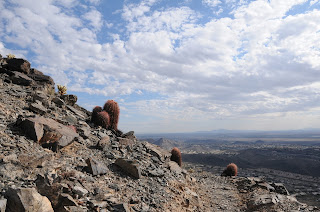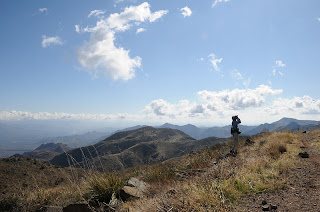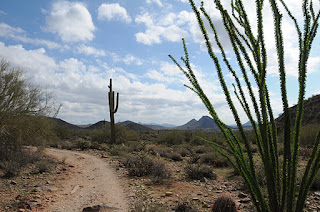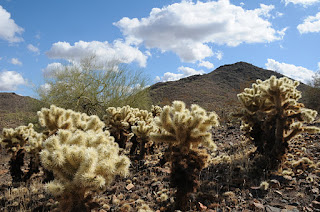CAVE CREEK TRAIL #4
Tonto National Forest
The product of both a growth anomaly and miraculous survival, a ginormous crested saguaro cactus, sporting a fabulous fan-shaped cap, is a keynote attraction of this popular hiking route. Biologists remain stumped about how the bizarre fan-shaped tops of crested saguaro cactuses form citing genetic mutations, lightning and other forces of nature as possible culprits. Adding to the allure of this aberrant plant (located roughly 3 miles from the east trailhead) is its survival of the 2005 Cave Creek Complex Fire which destroyed much of the surrounding vegetation. In addition to this trademark biological wonder, the trail is steeped in enchantment, passing among rolling desert hills, trickling creeks, magnificent canyons, forests of sycamores, mesquite bosques and heady, go-on-to-forever vistas. It's impossible to hike this trail and not be moved by its extraordinary beauty.
The trail runs east-west, and can be accessed from the west at Spur Cross Ranch or the east at Seven Springs Recreation Area. The shallow flow of Cave Creek anchors both terminuses while a maze of scrub-laden hills and valleys fill the in-betweens. This is an especially beautiful hike during “desert autumn” (November thru mid-December) when the creekside foliage glows in shades of gold.
RATING: moderate
ELEVATION: 3,280'-2,960'
DOGS: dogs must be on leash. There have been recent reports of rabid bobcats in the area, so be sure your dog’s shots are up-to-date.
BEST SEASON: October - April (December is primo!)
BEST SEASON: October - April (December is primo!)
EAST Cave Creek Trailhead: From the Loop 101 in Scottsdale, take the Pima/Princess Road exit and go 13 miles north on Pima to Cave Creek Road. Turn right (east) and go 12.5 miles on Cave Creek Road (a.k.a FR 24 and Seven Springs Road) past Seven Spring Recreation Area to Cave Creek trailhead on the left located between MCDOT mile markers 12 and 13. Roads paved up to the last 10 miles, which are maintained dirt/gravel, passable by passenger cars when dry. Two minor creek crossings are required—do not attempt after heavy rains.
WEST: Spur Cross/Skull Mesa Trailhead: From the park trailhead, hike 2.9 miles north on Spur Cross Road (FR48) to the Skull Mesa trailhead and pick up trail #4. MAP:
FACILITIES: restroom, picnic tables
FEES: Tonto Pass is NOT required as long as you park at the hiker trailhead only.
INFO: Tonto National Forest:
INFO: Tonto National Forest:
MORE PHOTOS:














































